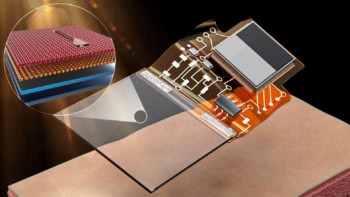Researchers in Germany have devised an extremely fast way of changing the value of a magnetic data bit using a current of spin-polarized electrons.
They claim that their technique could soon be used to create magnetic random access memories (MRAMs) that are as fast as conventional memory chips and have storage densities that are just as high. The big advantage of MRAMs is that they retain their data when switched off, which also means they could be used to create energy-efficient electronic devices.
Conventional fast memory chips, such as dynamic and static random access memories (DRAMs and SRAMs), store data bits in the form of electrical charge in tiny capacitors. When their power is shut off, the data rapidly leak away.
As well as being responsible for the annoying “boot time” when a computer is first switched on, in which data get transferred from the hard-drive to the memory, conventional memory also needs lots of energy just to store information.
Magnetic nanopillars
Most chipmakers believe that MRAM — in which data bits are stored in tiny “nanopillars” of magnetic material — offer the best way of creating a fast memory that does not need to be powered all the time.
Most MRAMs use a tiny magnetic coil near to the nanopillar to switch the direction of its magnetization and so flip the bit from, say, “0” to “1”. However, it is a tricky business making coils small enough to achieve MRAM chips with bit densities as high as those found in DRAM or SRAM.
One solution is to forget about having a bulky coil and instead flip the nanopillar by passing a pulse of spin-polarized electrons through it. Most spins in such a pulse point in a specific direction (up or down) and their magnetic moment exerts a “spin torque” on the magnetization of the nanopillar.
In prototype spin-torque MRAMs made to date, however, this process is much too slow. The snag is that the magnetic moment oscillates for about 10 ns before settling into its new orientation, which is about 10 times too long to be practical.
This has frustrated physicists, because in theory it should be possible to flip the magnetization in about 1 ns.
Speedier flip
Now Hans Werner Schumacher and colleagues at the PTB standards lab in Braunschweig and the University of Bielefeld have shown that by carefully controlling the temporal shape and length of the pulse — and by applying a small constant magnetic field — a nanopillar can be flipped in just 1 ns (Phys Rev Lett 101 087201).
Shumacher told physicsworld.com that the magnetic field “puts the magnetization into a well-defined position where switching is easiest”.
The team carried out their experiments using commercial prototype spin-torque MRAMs made by Singulus Nano Deposition Technologies in Frankfurt. While external coils were still used to generate the magnetic field, Schumacher believes that a similar magnetic field could be created in the vicinity of each nanopillar by carefully designing the shape of the memory bit.
Commercial technology
“Our technique is the first way of getting reliable switching to one nanosecond”, said Schumacher, who believes that the technology could be included in commercial MRAMs by 2010.



